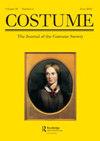“皮草大衣和迟钝的词汇是不合适的”:一战期间弹药女郎的时尚和阶级表现
IF 0.3
4区 社会学
0 HUMANITIES, MULTIDISCIPLINARY
引用次数: 0
摘要
这篇文章对第一次世界大战期间时尚是如何被用来识别和传播围绕爱国主义和阶级的话语提供了新的见解。官方指令鼓励节俭;因此,任何铺张浪费都被视为不爱国。以所谓的女性与战争现实脱节为目标的战时叙事被描绘在讽刺漫画中。上层社会的女性被描绘成穿着昂贵、崭新、“破烂”的衣服,而下层社会的军需品工人则被指责穿着皮草大衣,这在以前是他们负担不起的。昂贵的皮草历来被认为是富人和王室阶层的专利。因此,下层阶级女工穿着这种服装,即使是用更便宜的毛皮制成的,也会导致人们认为她们行为不当。漫画从阶级的角度描绘了消费者的行为,这进一步巩固了穿着皮衣的军火商从战争中获利的比喻。本文所分析的漫画与工人阶级妇女的实际购买进行了对比,以对第一次世界大战期间对弹药工人的夸张谴责进行更细致的解释。本文章由计算机程序翻译,如有差异,请以英文原文为准。
‘A fur coat and a blunted vocabulary are misfits’: Representations of Munitionettes’ Fashion and Class during the First World War
This article offers new insights into the way fashion was used to identify and disseminate discourses surrounding patriotism and class during the First World War. Official directives encouraged frugality; thus any extravagance was deemed to be unpatriotic. Wartime narratives targeting the alleged disconnect between women and the reality of war were depicted in satirical cartoons. Upper-class women were depicted wearing expensive, new, ‘ragged’ clothes, whereas lower-class munition workers faced accusations of profligacy exemplified by the wearing of fur coats, previously out of their financial reach. Expensive furs had historically been considered the preserve of the wealthy and royal echelons of society. Therefore, the wearing of such garments, even if made from cheaper pelts, by lower-class female factory workers led to assumptions of their impropriety. Cartoons depicted consumer behaviour in terms of class, which further cemented the trope of the fur-wearing munitionette profiting from the war. The caricatures analysed in this article are contrasted with a consideration of the actual purchases made by working-class women, to add a more nuanced interpretation of the hyperbolic condemnation of munition workers during the First World War.
求助全文
通过发布文献求助,成功后即可免费获取论文全文。
去求助
来源期刊

Costume-The Journal of the Costume Society
HUMANITIES, MULTIDISCIPLINARY-
CiteScore
0.40
自引率
50.00%
发文量
27
期刊介绍:
Costume is the journal of the Costume Society. It is a scholarly, refereed, academic publication presenting current research into historic and contemporary dress. The journal publishes articles primarily object-based, from a broad chronological period and with a worldwide remit. Costume maintains a balance between practice and theory and concentrates on the social significance of dress. Articles are welcomed from established researchers and those new to the field. The articles published in Costume are sent out for peer-review to ensure that they are of a high standard and make a contribution to dress history.
 求助内容:
求助内容: 应助结果提醒方式:
应助结果提醒方式:


